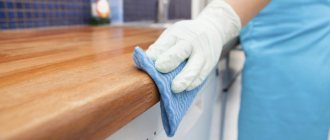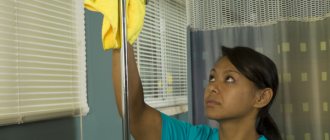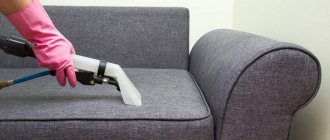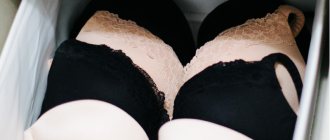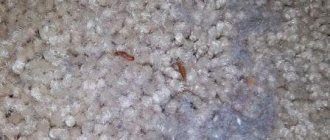26.11.2018 09:13
Disinfection of cleaning equipment is an event that must be carried out in all medical institutions, premises associated with public catering, trade, sports facilities, baths, swimming pools, beauty salons, and places where there are a large number of people. To maintain a favorable sanitary and epidemiological situation, all activities must take place in accordance with established norms and rules.
Cleaning equipment includes buckets, basins, mops, brooms, dustpans, and cleaning material. In accordance with SanPiN 2.1.3.2630-10, rags for floors, walls, tables and other surfaces must be processed and stored separately. Also, cleaning material is stored separately and used for different types of premises - offices, bathroom corridors. Disinfection of rags, even if the material is planned to be sent for washing in the future, is mandatory.
Why do you need labeling of cleaning equipment?
Labeling cleaning equipment according to SanPiN, a sample of which is given in this article, is necessary to prevent cross-contamination of pathogens during cleaning of different areas of the same institution. The marking of equipment for cleaning premises is regulated by a set of Sanitary Rules and Standards.
From January 1, 2022, the Decree of the Chief State Sanitary Doctor of the Russian Federation dated May 18, 2010 No. 58 (as amended on June 10, 2016) “On approval of SanPiN 2.1.3.2630-10” became invalid.
And a new decree of the Chief State Sanitary Doctor of the Russian Federation dated December 24, 2020 No. 44 “On approval of sanitary rules SP 2.1.3678-20 “Sanitary and epidemiological requirements for the operation of premises, buildings, structures, equipment and transport, as well as the conditions of business activities” came into force entities engaged in the sale of goods, performance of work or provision of services" (Registered with the Ministry of Justice of Russia on December 30, 2020 No. 61953).
Disinfection: what is it, features of the process
Cleaning equipment is a set of devices used in organizations for cleaning premises. After each use, rags, mops and other products are disinfected, which reduces the risk of the spread of germs and parasites.
The term “cleaning equipment” means the following devices:
- rags, napkins (paper, microfiber), brushes and sponges;
- mops and attachments, rollers;
- dustpans for collecting garbage;
- mobile carts, buckets;
- containers for preparing solutions of disinfectants.
A special feature of cleaning equipment is the presence of special markings in different colors that determine whether they belong to a particular group.
Important! When choosing a disinfectant, it is necessary to take into account which group the cleaning material belongs to. Disposable cleaning devices are not processed.
Processing Features:
disinfection is carried out in groups, depending on the material;- the higher the concentration of the solution, the shorter the treatment period;
- To protect your hands from exposure to substances, you must use rubber gloves; when working with potent agents, you should use a protective mask and goggles;
- After processing, it is necessary to place the equipment in a specially designated place.
Disinfection of rags, instruments and materials is carried out in separate rooms and includes the processes of cleaning, direct processing, drying and irradiation.
Marking of cleaning equipment at catering establishments
It is not regulated by a clear purpose of colors. Therefore, each enterprise can independently designate its own colors for each zone. For example, red is for cleaning a meat shop, blue is for a fish shop, green is for a vegetable shop, yellow is for a flour shop. Employees often wonder what color equipment is used to clean the distribution area ? – you can use green color, it can also be used for cleaning equipment of bar counters and tables where food is consumed.
Another frequently asked question: is specially marked cleaning equipment required for refrigerated rooms ? – the answer is definitely “Yes!”, for cleaning each group of premises (hot and cold shops, meat and fish shops, flour and confectionery shops, semi-finished products preparation shops, procurement shops, non-refrigerated warehouses, refrigerated chambers, auxiliary premises, sanitary facilities ) allocate separate marked cleaning equipment, in accordance with the requirements of SanPiN 2.3.2.1324-03 “Hygienic requirements for shelf life and storage conditions of food products.”
The main goal and conditions of the events
Disinfection of cleaning equipment is carried out in order to prevent the spread of microbial and bacterial infections that can settle on rags and materials used. Subsequent drying and identifying a special place for storage allows you to get rid of the unpleasant musty smell and maintain the quality of the devices.
Algorithm for disinfecting mops and rags:
- Prepare the solution in accordance with the manufacturer's recommendations. Use separate containers to make the mixture.
- Place a rag in a bucket with the resulting solution and leave for a certain period of time (according to the manufacturer’s recommendation based on the concentration).
- After a while, remove the rag from the solution and rinse well under running water. During the process, use rubber gloves to protect your hands from exposure to aggressive substances.
- Dry the cleaned and disinfected item and put it in a place of permanent storage.
Note! To disinfect mops and carts for cleaning equipment, you need to wipe the equipment with a rag generously soaked in a disinfectant solution.
Color coding of cleaning equipment
Very often, workers in various fields are faced with the question of what color rags and cleaning equipment for cleaning bathrooms are coded according to the international cleaning marking system ; the answer to this question is given in the table below.
| Equipment that is used in rooms with a high degree of bacterial contamination (toilets, bathrooms, storage rooms for dirty linen) is marked red. |
| Green color is used to mark equipment that is subject to more stringent cleanliness requirements (operating room, areas for storing, preparing and consuming food, kitchen, bar counter). |
| Blue or cyan color is applied to equipment and inventory used for places with slight contamination (corridor, reception areas, shop windows, lobby, office, hospital ward, resident's room, hotel room, classrooms in schools and preschool institutions). |
| Yellow color is used to mark equipment used for cleaning conditionally dirty premises (gyms, warehouses and utility rooms). |
| Cleaning equipment marked white can be used for cleaning other rooms. |
Go to the cleaning equipment catalog
Storage rules
Rules for storing cleaning equipment:
- Only equipment that has clear markings is sent for storage - if it has become illegible, it needs to be updated;
- It is prohibited to use equipment for other purposes;
- all cleaning equipment should be stored in special cabinets - mops and brushes are placed vertically, mounted on special holders;
- do not store brushes, buckets and rags that are used for cleaning in different rooms together;
- Only disinfected buckets, mops, etc. are put away for storage;
- you cannot leave inventory for storage anywhere other than a special room;
- disinfectants and detergents must be stored in the manufacturer’s packaging, with the label intact;
- sanitary rooms should be equipped with sinks, they should provide places for storing garbage and materials that have become unusable; it is desirable to have outlets with low taps for collecting water in buckets.
Compliance with storage rules is a prerequisite for working with equipment in medical institutions. Failure to comply with them may cause the spread of infections.
All working personnel must be familiarized with the rules for working with cleaning devices.
Marking of cleaning equipment (sample)
InventoryPurposeMarkingMarking methodBucket For cleaning toilets UB Oil paint on the outer surface of the bucket Brush, mop For washing floors For floors Marking is applied with oil paint on the handle of the brush or mop handle, if the handle or handle is made of wood, then the burning method is used Burlap For washing bathrooms A red flap A red flap is sewn onto the corner of the burlap Napkins For washing the walls of corridors With green napkin colorsCleaning cloths are used in different colors for each zone. Mops for cleaning floors in a hotel room. Mops are blue or the colored tags are cut off and only the blue label remains. Mops for cleaning can be either in different colors (corresponding to each cleaning zone), or with sewn-on colored labels in four different colors, three of which are cut off and one label of a certain color remainsConditions for disinfecting cleaning rags
The rags are soaked in a 3% solution of sodium bicarbonate, 6% table vinegar or in a solution of a product specially designed for disinfection measures. Despite the fact that the disinfectant solution is removed by rinsing, it cannot be ruled out that some percentage of it will still be contained in the rags. Therefore, the following requirements are imposed on it: the disinfectant must have a good wetting effect, cleansing properties and be destructive for most common pathogenic microorganisms, but at the same time not cause harm to humans and not damage the coating of furniture, floors and walls and not lead to increased corrosion of metal tools and furnishings
You may also be interested in:
- Using rags
- Instructions for processing rags
- Floor cleaning cloth
- Rules for marking rags
Marking of mops according to SanPiN
Should be applied to the handle or handle of the mop. You can, of course, mark with oil paint or a marker, but this is an unreliable and outdated method, since the paint and marker quickly rub off from the surface. Today, handles from ]TTS[/anchor] (TTS) are developed taking into account the requirements of SanPiN and are marked with a cap of a certain color at the end of the handle. Another advantage of such handles is their ergonomics - they are telescopic and adapt to the operator’s height.
Color marking
- Red color. Indicates that this equipment is used for cleaning rooms with heavy bacterial contamination (toilets, rooms with dirty linen, etc.).
- Green color. The equipment is intended for cleaning rooms and surfaces with high requirements for cleanliness, for example, in which food products are prepared and consumed (vegetable shops, kitchens, etc.).
- Blue color. The equipment is used for cleaning areas with minor sanitary requirements (offices, lobbies, etc.).
- Yellow. Cleaning equipment is designed to work with all other surfaces that are not included in any of the above groups. These could be gyms, warehouses, etc.
The use of color marking of cleaning equipment according to SanPiN allows you to avoid the transfer of contaminants and various microorganisms from one area to another, as well as infection with dangerous diseases.
Cleaning equipment for medical institutions
Carts, mops, containers, rags, mops must be clearly marked or color-coded taking into account the functional purpose of the premises and types of cleaning work and must be stored in a designated area. The rags are marked as follows: rags for cleaning in staff rooms and wards are marked in blue; red - for cleaning bathrooms; green – dressing rooms, treatment rooms; yellow – utility rooms.
A color coding scheme for cleaning equipment in medical institutions should be located in the equipment storage area.
Toilet cleaning equipment must be color coded to indicate special attention. Cleaning equipment for the toilet: rags, buckets, brushes are labeled and stored separately from other cleaning equipment.
Equipment for cleaning toilets must be clearly marked in red, which is used in areas with a high degree of bacterial contamination. In the specialized literature there is often a definition that cleaning equipment for cleaning bathrooms must have a signal marking .
Should cleaning equipment for production, utility and auxiliary premises be marked with paint ? – the answer to this question is definitely “Yes!” Also, such cleaning equipment should be stored in separate rooms equipped with special washing baths ( washing equipment ) and drainage devices with hot and cold water supply, as well as a register for drying cleaning equipment.
Set of cleaning tools and accessories
The list of tools and devices for cleaning depends on the focus of the medical institution, its area, traffic flow and more.
The classic set looks like this:
- Surface cleaning and disinfection products. They can be liquid, paste-like, granular. All substances must dissolve well. It is possible to use only low-toxic compounds without a pungent odor or irritating effect on mucous membranes or skin.
- Sponges and rags.
- Buckets, containers for treating walls, mops, brushes, screeds, mops.
- Container for detergents and disinfectants.
- Garbage bags.
- For mechanized cleaning: vacuum cleaners, floor washing machines, steam generators.
- Cleaning trolleys.
A medical facility must have all the necessary equipment for both wet and dry cleaning.
If rags and buckets are used for daily activities, then more equipment is required for general cleaning. Its implementation can be simplified with the help of mechanized equipment.
List of cleaning equipment subject to mandatory marking:
- Buckets
- Buckets on wheels
- Floor rags (rags)
- Mops
- Mops
- Handles
- Brushes
- Broom
- Scoop
- Squeegees for windows and floors
- Scrapers
- Cleaning trolley
- Bucketless cleaning trolley
- Microfiber cloths
- Trash cans
- Cleaners
- Garbage containers
To summarize, color coding helps:
– avoid cross-contamination and contamination with microbes and bacteria. The reputation of each establishment in the HoReCa sector is very expensive, therefore, in the fight for your client, you must take all possible precautions. And the healthcare, public nutrition and education systems need this vitally.
– marking of cleaning equipment allows you to determine which contamination zone the equipment belongs to, which makes it much easier for management to monitor compliance with cleanliness standards.
Service
Equipment that has been used must be properly maintained.
Three main stages:
- disinfection using specialized solutions;
- rinsing in clean water;
- drying.
Only after completing these procedures can it be sent for storage. It is recommended to use disposable wipes for cleaning. If this is not possible, they resort to using reusable products, with their obligatory washing.
Washing machines for this purpose are installed in those places where cleaning carts are collected. Squeegees, mop holders and brushes are treated after each use .
Before using reusable mops and napkins for the first time, they need to be washed to remove the impregnation applied by the manufacturer, make them softer and increase absorbency.
For washing, it is recommended to use liquid detergents, which are better washed out of textiles. Avoid using rinse aids.
Types and procedure of cleaning in a medical institution
It should be done twice a day.
In addition to maintaining general order, the nurse must disinfect used instruments, dressings, and items used when drawing blood. At the end of the day, another type of cleaning is carried out in the hospital - final cleaning.
It is necessary in order to complete the working day by clearing the premises of contaminants. General cleaning is carried out at different intervals depending on the functionality of the office:
- utility rooms must be generalized twice a month.
- the premises of the ward departments are processed once a month;
- the operating unit, treatment rooms, dressing and vaccination rooms, as well as sterilization rooms must be cleaned every week;
To carry out general cleaning, medical personnel must wear replaceable overalls, as well as special protective equipment.
Requirements for toilet equipment
Mandatory disinfection of all equipment
Cleaning equipment for the toilet, rags, buckets, brushes, are labeled and stored in a special room in a closet or niche. In this case, funds that have different purposes are stored separately from each other. It is worth pointing out that the soles of mop holders with mops should not come into contact with the floor. They are located separately from each other. In this case, textile wiping materials should be placed on racks or hung. Alternatively, dryers are used for this.
It is also worth highlighting the fact that routine cleaning with disinfection should be carried out several times a day, and general cleaning - once every 7 days. In this case, disinfectants for washing must be selected in accordance with the profile, epidemic situation and the object of treatment. Before doing this, they must be labeled. When patients are nearby, it is allowed to use only those disinfectants that have a hazard class of 4. The irrigation method cannot be applied immediately; wiping with a cloth is used for this.
The entire set must be disinfected before use. The premises where cleaning personnel are located are equipped with trays, sinks, sedimentation basins and watering devices. Cleaning equipment must be thoroughly washed after use before the next storage. Something is sent for destruction.
Note! Typically, dirt is removed from the tools and replacement attachments are replaced. No rinsing agents are used in the work. The temperature is selected based on the materials.
SanPiN requirements for cleaning healthcare facilities
Wet cleaning of premises (cleaning floors, furniture, equipment, window sills, doors) must be carried out at least 2 times a day, using detergents and disinfectants approved for use in the prescribed manner.
The administration of health care facilities organizes preliminary and periodic (at least once a year) instructions for personnel cleaning premises on sanitary and hygienic conditions and cleaning technology. 11.2. Storage of detergents and disinfectants should be carried out in the manufacturer’s containers (packaging), equipped with a label, on racks, in specially designated places. 11.3. Containers with working solutions of disinfectants must be equipped with tight-fitting lids, have clear inscriptions or labels indicating the product, its concentration, purpose, preparation date, and expiration date of the solution.
11.4. When working with disinfectants, all precautions must be observed, including the use of personal protective equipment specified in the instructions for use. 11.5.
SanPiN 2.1.3.2630-10 “Sanitary and epidemiological requirements for organizations engaged in medical activities.” Excerpt. Clause 11. Sanitary maintenance of premises, equipment, inventory
Replaces: SanPiN 2.1.3.1375-03 “Hygienic requirements for the placement, design, equipment and operation of hospitals, maternity hospitals and other medical hospitals” SanPiN 2.1.3.2195-07 “Hygienic requirements for the placement, design, equipment and operation of hospitals, maternity hospitals and other medical hospitals.
Amendment No. 1 to SanPiN 2.1.3.1375-03″ SP 3.1.2485-09 “Prevention of nosocomial infections in surgical hospitals (departments) of medical organizations. Addendum No. 1 to SanPiN 2.1.3.1375-03" SanPiN 2.1.3.2524-09 "Sanitary and hygienic requirements for dental medical organizations. Amendment No. 2 to SanPiN 2.1.3.1375-03" SanPiN 3.5.2528-09 "Organization of disinfection and sterilization measures in medical and preventive organizations.
Addendum No. 2 to SanPiN 2.1.3.1375-03″ SanPiN 2.1.3.2576-10 “Hygienic requirements for the location, design, equipment and operation of hospitals, maternity hospitals and other medical hospitals.
Types of cleaning in medical and educational institutions
The article contains examples and detailed calculations. Health care facilities are required to carry out wet cleaning with detergent and disinfectant solutions.
Dry cleaning is prohibited. This is specified in clause 11.1 of SanPiN 2.3.1.2630-10.
The type and frequency depend:
- on the intensity of surface contamination;
- degree of risk of occurrence and spread of infection.
- frequency of contact with the hands of patients and staff;
There are two types of cleaning: routine and general. Perform the current one twice a day before starting work and at the end of the working day.
How to properly label and store inventory according to SanPin
Proper storage of disinfectant solutions according to Sanpin
Detergents and disinfectants must be stored in packaging from the manufacturer, where there is a label. To do this, you should take separate containers to dilute working disinfection solutions:
- to disinfect and sterilize products for medical purposes, as well as pre-clean these substances;
- to disinfect surfaces on furniture with apparatus, instruments and equipment;
- to disinfect cleaning material, class B and C waste in the absence of disinfection installations.
Containers containing working disinfection solutions must have tight-fitting lids with clear writing or labels.
Color coding is required to more accurately distribute rags and other tools into zones, preventing cross-contamination and bacterial contamination during cleaning activities. Some organizations use four-system color marking and coding to mark buckets, trash cans, mops, telescoping handles, sponges, gloves and other cleaning materials, and to separate cleaning areas. Other companies have colored clips, handles, clips and attachments with tags.
Note! Red coding and markings are used to clean toilets and bathroom floors. This color is often used to mark cleaning areas for sanitary rooms and medical waste areas.
The areas of kitchen tables, bar counters, production facilities and cleanliness in the dining room are marked in green. As a rule, it is used for more efficient cleaning of the dressing room and treatment room.
Tools for cleaning various storage areas are marked in yellow, and wards, staff rooms and corridors are marked in blue.

